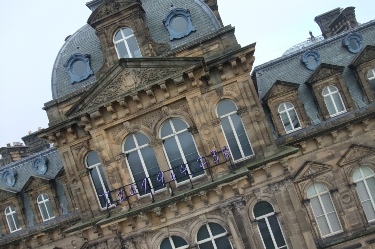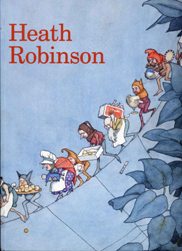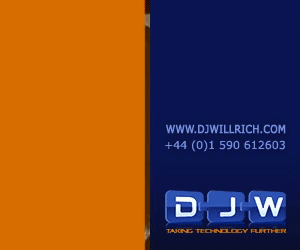Geoffrey Beare, Trustee, the William Heath Robinson Trust:
The William Heath Robinson Trust (WHRT) was established in 1992 to conserve and exhibit the collection assembled by his daughter. It holds over 500 original artworks by Heath Robinson, as well as letters, books, magazines and ephemera containing examples of his work. The main activity of the trust has been to mount exhibitions of works, including a popular touring exhibition which has been shown at nine major venues around the UK since 2003. The Trust was always seeking a permanent home for the collection. Initially we looked at established museums, or even National Trust properties, but found nothing that came close to meeting our requirements for a permanent display space. In 1998 we established contact with the community in Pinner and discovered that we had complementary needs that would be met by restoring West House and building a new museum there. A new Trust, the West House and Heath Robinson Museum Trust (HRMT) was established to manage the project.
Alison Nicholson, Digital Communications Officer at The Bowes Museum:
The Bowes Museum was founded in the 19th century by a local business man, John Bowes who met and married his wife Joséphine, a French actress, in Paris. As well as a love for each other, they shared a love of fine and decorative art and together they began collecting a vast array of beautiful artefacts including paintings, furniture, glass, ceramics, silver, toys and textiles. They decided to build a Museum to house their collection in rural Teesdale, part of the Durham Dales. In 2005, the Museum began a series of capital developments to improve the visitor experience and refurbish the galleries. As part of the ambitious exhibitions programme, to bring internationally renowned art to the North East, the Museum embarked upon a series of contemporary art exhibitions including Damien Hirst, Print Maker, Vivienne Westwood Shoes, Keith Coventry bronzes and Tim Walker photography. As part of this series, an exhibition of neons by Gavin Turk, one of the well known Young British Artists of the 90s was planned to include a neon installation on the Museum’s exterior to broadcast the world’s population at the time of the opening of the exhibition entitled: ‘Seven billion two hundred and one million nine hundred and sixty-four thousand two hundred and thirty-eight’.

How are you currently funded (including details of HLF funding)?
GB: The development phase was funded with a 92% grant from HLF. HRMT manages West House and is funded largely by rents from the café and second floor commercial space which are leased to the operators, and by lettings of first floor rooms for functions. WHRT manages the collection and is funded by fees from the touring exhibition which started at Dulwich Picture Gallery in 2003 and by sales of merchandise, primarily books and postcards. The new museum delivery phase has been awarded a £1.13M grant by HLF. We have to raise £430k in partnership funding. So far we have received or had pledged £129k from Trusts approx. £29k from Kickstarter after costs and £32k so far from a local individual giving campaign in Harrow. HRMT will contribute £50k from its own funds.
AN: The Museum is funded by grants from Durham County Council, Arts Council England, Heritage Lottery Fund and various Trusts and Foundations. We also rely heavily on individual donations towards our Catalyst Endowment Fund, and receive support from our Friends Association, along with visitor admissions which we hope to grow to become more self-reliant. The Gavin Turk exhibition was funded in the main by Arts Council England Grants for the Arts funding.
Why did you decide to try Crowdfunding? And why did you choose Kickstarter (from the many sites that are out there)?
GB: Traditional funding routes were proving very difficult. There is a worldwide appreciation of Heath Robinson’s work and crowdfunding would enable us to reach out to that audience and demonstrate the breadth of support that exists for our project. Kickstarter was chosen as a well-established, reliable site with a good track record in the visual arts.
AN: Crowdfunding featured in a couple of training courses I attended, including one where I met a representative from Kickstarter. Raising funds for the Gavin Turk neon installation seemed a perfect project to involve new audiences and Kickstarter was our preferred platform as Gavin Turk and his wife Deborah had used it to raise funds for their charity The House of Fairy Tales. We hoped there would be backers on Kickstarter who already knew Gavin’s work.
How much were you trying to raise and how much did you succeed in raising?
GB: We initially planned to aim for £38,500 but having assembled our material and rewards we decided that was too ambitious and lowered our target to £32,500. In the event we raised £33,492.
AN: We were aiming for £6,000 and managed to raise £8,680.
What rewards did you offer those who contributed?
GB: We offered single postcards (£6 or more) and sets of five postcards in a specially printed envelope (£15 or more). Signed copies of a Chris Beetles catalogue (donated) (£28 or more) and of “The Art of Heath Robinson” book (from Trust Stock) (£40 or more). An e-book version of Heath Robinson’s rarest picture book for children (£35 or more). Limited edition prints at £50, £75 (x2) and £150. An opportunity to have lunch at West House with the Architect, Designer and Curator (£100). Name up in the entrance to the museum and a special opening event (£1000) and this plus an original drawing (£5000). At the suggestion of backers we added all four limited edition prints (£350) and two larger prints (£160 and £260)

AN: We were very fortunate to have some great rewards donated by Gavin Turk. These rewards ranged from bronze badges, tote bags, boxed postcards and t-shirts to limited edition prints of Turk’s iconic works. We asked for contributions from just £1 in return for a simple ‘thank you’ to £1,000 for an unframed edition of ‘Gold Triple Pop’.

Do you have any idea who the people were who were contributing and why they chose this particular method?
GB: The majority of backers seem to be ordinary people who have a deep appreciation of Heath Robinson’s work. They contributed this way because this was how they heard about the project and there was no easy alternative at the time. At least half of them also wanted one or more of the rewards on offer.
AN: We shared the Kickstarter campaign with all of our online followers on social media, the Friends of The Bowes Museum, contacts within other museums and galleries and asked them to share our project with their own online networks. The backers were a mix of existing supporters of the Museum and Gavin Turk, and completely new donors from Europe and the USA. We were lucky to have our campaign chosen as ‘Staff Picks’ on Kickstarter which allowed us to reach a whole new global audience. Also, an article in our local newspaper was seen by a member of worldwide population charity Population Matters. The Chief Executive of the charity kindly shared our project with their 10,000 members and raised awareness of our campaign through their social media channels. From a personal point of view, I think the project captured the imagination of the backers as the prospect of a 21st century conceptual art installation on the façade of a 19th century Museum in rural Teesdale was both ambitious and creative.
Has your experience of this method of fundraising been positive or negative and if so why?
GB: On balance, very positive. The cons are that it is very hard work and a nail-biting “all or nothing” process. On the positive side, it generates a great deal of publicity, allows you to reach a much wider audience and to demonstrate breadth of support, and shows other funders that you are innovative and willing to “think outside the box”.
AN: On the whole it was a positive experience. It was our first attempt at crowdfunding and we have learnt a lot along the way. We were overwhelmed by the support we received from our existing audience and new donors and hope we can build on the relationship we have initiated with the ‘crowd’ we engaged during the campaign.
Do you have any tips for other institutions who may be considering this option for themselves?
GB: Develop your social media contacts well in advance. Identify key allies – we would not have succeeded without support from Michael Rosen, both in our video and tweeting for us. Think through your reward structure – a good range of donation levels and cater for people who want combinations of rewards (Kickstarter only allows backers to choose one option). Make sure that you have a team available full time to generate press coverage, be active on social media and field enquiries from potential donors. Strong national press coverage in the early days of the campaign is vital. We had good coverage for the project ahead of the campaign, but nearly came to grief because a promised article in a National paper in the first week of the campaign did not materialise.
AN: The key to success is planning. It is advisable to get everything ready in advance and to know who you are going to contact throughout your campaign in order to maintain the momentum. Offline activity such as media coverage helps considerably to spread the word and having a good range of rewards for backers is crucial.
Back to top




